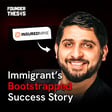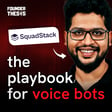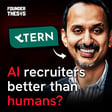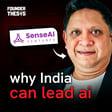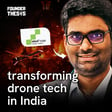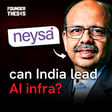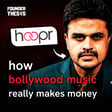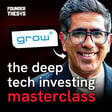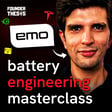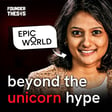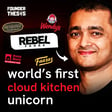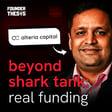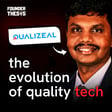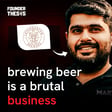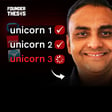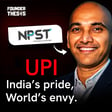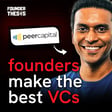Become a Creator today!Start creating today - Share your story with the world!
Start for free
00:00:00
00:00:01

Helping companies monetize content | Sunny Sen @ ConScent
News and journalism are shifting their strategy from being free for consumption to going behind paywalls. ConScent is building a full-stack revenue solution for publishers, and in this episode, Sunny talks about the publishing landscape and the various ways to monetize content through smart user journeys and better intelligence.
Insights shared:-
- The business case of subscriptions
- How to customize paywalls
- Pricing strategy
- How will the publishing industry evolve
Additional links:-
Transcript
Introduction to Sunny Sen
00:00:00
Speaker
Hello folks, I am Sunny Sen, co-founder and CEO of content.ai, a user life cycle management platform for media companies at large.
The Shift to Subscription Models in Media
00:00:22
Speaker
There was an era when no one thought that people would pay to watch movies online. After all, you had free options like YouTube and piracy was pretty rampant. But today, I'm sure most of you listening to this podcast would have subscribed to a video streaming platform like Netflix. The business of news and journalism is going through a similar journey, from being free to read to now going behind paywalls. This tectonic shift has already happened in the US with most publishers using paywalls and is increasingly getting adopted in India also.
Tools for Paywalls in Publishing
00:00:51
Speaker
And as we have said before, in a gold rush, the best way to make money is by selling shovels. In this episode of the Founder Thesis Podcast, your host Akshay Dutt is talking to Sunny Sen, the co-founder and CEO of consen.ai, which is providing tools to publishers to help them make the switch to paywalls.
00:01:08
Speaker
Consent is building a full-stack revenue solution for publishers, and in this episode, Sunny talks about the publishing landscape and the way to space to monetize content through smart user journeys and better intelligence. Stay tuned and subscribe to The Founder Thesis Podcast and any audio streaming platform to learn about how to sell shovels in a gold rush.
Sunny's Career Beginnings and Journalism
00:01:35
Speaker
I was pretty much an ambitious child. I come from the small town Rachi, come from a business family. My dad was a businessman. Well, I was the first person in my entire family to do a job. I joined my dad's business in 1998. I expanded the business, build a wholesale distribution for the liquor business in over the next six years. From 1998 to 2004, I ran that business.
00:02:01
Speaker
but he definitely wanted me to complete my graduation. And I said that, Hey, let's go to Delhi. Let's complete my graduation Delhi. And then go back to Rachi, join the business and build a business and so on and so forth. When I completed my graduation, so I took up a course in Diploma in Journalism in Parthi with Diyapavan. And one day a few of my friends who were there in IMC, who were there in Jamia, they said that NDTV has an internship.
00:02:27
Speaker
I said that I do not want to do an internship because this is just more of spending time in Delhi kind of a situation. But I ended up going for the internships. Fortunately, we were 20 of our friends who went there to give for an internship. The two of us who qualified were the two of us who didn't want to work in Delhi. And that's how the journey started. What were you covering? I used to cover crime and Delhi politics.
00:02:52
Speaker
Like NDTV is like a channel. So you were in front of the camera behind the camera? Yeah, in front of the camera. In front of the camera.
Transition to Business Journalism
00:03:00
Speaker
Yeah. So that's 2007. And you moved from being in front of the camera to being a reporter who was writing articles and all that. Just helped me understand your evolution and what kind of skills were you learning. So I was always a reporter.
00:03:15
Speaker
I was never a desk person. So journalism has three, four large buckets. So there are people who report, then the reporters report to their bosses who are editors or vertical editors and so on and so forth. And then there is a desk. So whether the desk is there in digital, print and television, the desk actually edits whatever you file, whether it's a television report or so on and so forth. And then there are people who are in the production unit and there are designers.
00:03:40
Speaker
So, broadly, this is the structure for any media organization. So, I was always on the reporting side. So, we used to call ourselves the shop floor guys who were producing the content and the desk guys are the people who package the content and the platform distributes the content. So, I was always creating the content, getting the news, reporting, talking to people, doing interviews, coming back, filing the first draft, second draft, doing
00:04:07
Speaker
my bit of editing, my bit of writing and a little bit of spit and polish. And then usually it used to be horrible. And it used to be written from first word, last word, so on and so forth. And then I joined this voice and data. There was this company called Cyber Media. It still is where I started covering telecom. The voice and data magazine was only for the telecom industry. It was a B2B telecom industry magazine.
00:04:28
Speaker
The reason why I moved to business journalism was primarily because I thought business journalism is something which I would understand a little bit more because I came from a business background and I did understand business a little bit more than most of my colleagues of my age. So that is why I moved to
00:04:48
Speaker
But nobody was giving me a job because my resume only talked about how many murders I covered, how many rapes, duties I've coped, and how many border crimes I reported or all of that. But the cyber media gave me an option
Building Relationships in Journalism
00:04:59
Speaker
and I did decent. And then I moved to Business World when Business World was still part of ABP group and it used to be a weekly magazine. From there, I went to Business Today and Business Today is where actually my skill sets have left to do the best of my knowledge kind of thing.
00:05:15
Speaker
What was your specialization in terms of would you write say an insight about why something is happening or would you like what would most of your output be? In magazine, this was more about long forms, right? You write detail report. So I could never write.
00:05:33
Speaker
I still don't write this explainer that you have. So you analyze the news, you put your own opinion to it, explain why that happened. And I was more of a reporting person. So I would, if it is a story on say Vodafone, when the entire fiasco was happening, I would talk to everybody inside Vodafone. I would talk to people who look at Vodafone from an outside. I talked to competition, then piece the story together.
00:05:56
Speaker
360 degree reportage, deep dive reportage based story. That was my specialty. So I was doing corporate at large. I was more of a corporate reporter, eventually became from a startup, IT telecom reporter, I became a corporate reporter at large. And then eventually became corporate vertical head of sorts and associate editor and so on.
00:06:15
Speaker
then I moved to the Financial Express and then in Hindustan Times, that was a big challenge because Hindustan Times was a news platform. We did some of the long forms but it was only news and that was the challenge I wanted to take up in my life that I've done so much of long form but I want to see whether I can break news or not.
00:06:35
Speaker
And to my surprise, I could break news quite well. So I was averaging about three stories a day. Perhaps one more thing I've learned because of that transition that in the process, either you make build transactional relationships or you build real relationships.
00:06:53
Speaker
And how did you build real relationships instead of transactional relationships? So I would not name a few people, but I can say that some of the unicorn founders today that you see, I spend time with them, not just about the business. I spent time with them afterwards in the evening, late in the evenings, talking about what the struggles they're going through. We would discuss their product.
00:07:15
Speaker
We would actually talk about what would the new features be. It was not about journalism at all. It was more about being a part of their hustle struggle, built up phase. These were very small companies, which have become a $5 billion company, $4 billion company, $10 billion company, whatever it is today.
00:07:36
Speaker
Like Sandeep from Droom and Shop was like, I can see you've written like a biography. Yeah. They have become, over time they have become very good friends and now they are my mentors. Yeah. So they supported me when I started my video. And they are always there for me whenever I need their help. It's just a shout out kind of a thing.
00:07:56
Speaker
So you become part of the lives and you don't keep a transaction as just for a story, just for a breaking news. The equations of human lives have not changed in the past, you know, multiple centuries. It won't change in the next multiple centuries.
Founding Content.ai
00:08:10
Speaker
So you need to connect at the human level, be empathetic, be understanding. You need to look beyond that one story. Then you join factor daily. Yeah. Factor daily. What is factor daily? Yeah.
00:08:22
Speaker
So Factory Daily was a new age journalism platform like you have in our morning context today. But it's just that Factory Daily was not behind a paywall founded by Pankaj Mishra. And they wanted a good corporate reporter who could break stories. So that is how I joined. And my boss from business today was the editor there. And he asked me to join and I joined.
00:08:47
Speaker
And being a startup, and I also wanted to experience what a startup like. That was also the first time I got an ESOP to be part of the leadership team. And I didn't have any knowledge about what ESOPs are. Of course, I knew what ESOPs are, but I never had ESOPs in any of my previous companies. In Factor Daily, I joined them as the corporate and policy editor.
00:09:09
Speaker
I was part of the faculty-driven entire Reliance GEO, the big Reliance GEO battle between the rest of the telecom operators. Broke most of the stories at that point, even almost every single story of the Flipkart, Walmart merger was broken by me. I would arguably say that 70% of the stories that came out, the first stories that came out, the exclusives were done by me.
00:09:33
Speaker
Personally, I do not know if you would resonate with it or not. It's easier if you are with a very large company like An Economic Times, Maine. It's a standard to break it because you have the power of the brand alongside. People will pick up your call because you're calling from a big brand. But if you are with a small startup and still if you're able to break the stories, that is perhaps the biggest proof of relationships that you have built over time.
00:09:56
Speaker
Factor Daily is not a major player today. So what happened there? So Factor Daily pivoted into what is now a Media Labs. So they do very few, very deep dive stories for media organizations. They train journalists to do very good journalism.
00:10:12
Speaker
I didn't want to leave, but I'm not a media labs person, definitely not a media labs person, not a trainer of journalism. While this was happening, one of my previous bosses from business world, he was with economic times and he was creating, which was a dorially neutral branded content where you create content like series of content and then it gets sponsored.
00:10:36
Speaker
very well done by New York Times, very well done by Washington Post and so on. Where the journalism is not comparable, it's not an advertorial. Where you do good journalism, it's a series of stories on us topic and then the sales teams or the marketing team go and get people to sponsor that entire series.
00:10:54
Speaker
So, for example, this podcast you do. So, you're doing a series of podcast with founders, and then a company, say, Freshworks, okay? A VC fund, Freshworks, right? Freshworks, which has startups as a big cohort of their clients, they sponsor this podcast, this entire series.
00:11:13
Speaker
So Freshworks sponsoring this podcast has no bearing with the content of the podcast. That's what I've built. By the time it was 10 months, 11 months, Pankaj Mishra had joined Network A team as a group editor for the new economy, which is all startup related things, the entire new economy where the startup technology, new mobility, all of that.
00:11:36
Speaker
And Pankaj said that, hey, I need somebody to become the national corporatator. And it was a group-level role, across Money Control First and CNBC, and we wanted to start a television show. But by then, consent had already started happening in my mind, and Sean Naxmein, who was my co-founder. But when Pankaj went, I said, chill.
00:11:55
Speaker
Let's go there because it was not finalized. And the reason why you see the last two stints short is because of these reasons. And in January, I decided that I'll start up in 2020. And that was the end of my journalism career, acting as the first phase of my journalism career. I do not know if I will ever have to go back or not, but I should never say never.
00:12:15
Speaker
Yeah, okay. You spent maybe a decade and a half in this industry and your startup is also in the same industry. What were those dots that you connected to realize that, okay, this is something which this industry needs and I should build this and make a startup
Micropayments vs. Subscriptions
00:12:34
Speaker
on it?
00:12:34
Speaker
So, subscriptions were slowly growing. It had happened in the US. India always is a lagging innovator. We started doing things about 10 to 15 years after the US does and about seven to eight years after China does. And then there is applied innovation. So, the real innovation happens in the US and then India does an applied innovation and makes it slightly better for
00:12:59
Speaker
masses and across classes and and then they go wow well this is low cost and ice plate kind of a thing and subscription was one space where all of this was subscription was being laptop by everybody nyt wsj washington post bloomberg you just think everybody knows people had started paying for content
00:13:19
Speaker
Any respectable news site was behind a paywall. Yeah, Shlana kindly knew that. As an individual, you want to consume content, but when you are hit by a paywall, you do not buy every single subscription. You will not buy 20, 30, 40 subscriptions. So we knew that.
00:13:36
Speaker
But if there was an option for people just to pay for one news which he wants to buy, if he is not a loyalist of that platform for which he wants to subscribe, then there is a higher opportunity for generating
00:13:52
Speaker
revenue by just making that one piece of content payable instead of forcing the user to buy a subscription. Okay. Like a micropayment mechanism. Yeah. And alternate. And when we wanted to stitch the ecosystem so that if a user has micropayment on any platform, he moves to a second, third, fourth, fifth, sixth platform. How do we reduce the friction of payment there on the second, third, fourth, fifth, sixth platform?
00:14:16
Speaker
So we said that we should have a universal login, which allows the user not to fill in password, form, name, blah, blah, blah. If the second, third, fourth, fifth platform are also constant partners, the user just needs to move there, make the payment, boom, one click or two clicks, whatever it is.
00:14:35
Speaker
And the more you reduce friction, the every step you add, there is more drop-offs. If you can eliminate two or three steps from making a payment process, you're automatically conversion goes up. So we said that a universal login across all concept partners and micro payments as an alternate. That's how content started.
00:14:55
Speaker
But today it's a very different company. It looks at the industry through a very different lens. That was the starting point of the business. We have built on top of it. That still continues. We still say that micro payments is a very important con in the entire video. We say that micro payment is not a singular thing that will drive your business. Micro payments is a way to identify a very premium cohort of users who are willing to pay for your content.
00:15:21
Speaker
And on top of that, you need to have a very good analytics platform which understands that user. Eventually, you would need to understand what that micro peer wants to read, what are his interests. Also, you need an engagement platform to engage with that micro peer so that it does your platform again and again, and eventually become a subscriber.
00:15:42
Speaker
So it is one of the most important cogs in the wheel, but it's not the wheel in itself. So we wanted to be part of the paywall and we wanted to integrate with the media companies and we did try B2C. We tried to help media companies get more people to those pages which had premium content and that was a foolish idea and we should never have done it on all of that.
00:16:02
Speaker
So we always say that to build a B2C brand, first you need to get curate all the content on your platform, which is expensive. And then you need to get users on your platform, which is high CSC, cost of acquisition. And then it's a crazy loop. So we said that we'll always be, we'll always integrate with media companies, sit inside media companies, and we will fire the paywall. The paywall have, we'll have a subscription option, which is their own subscription option. And we'll power the microwave inside of it.
00:16:31
Speaker
So the forms users, so India today's users or outlooks users, they get the ways to access content and we will have a universal backbone stitching the entire ecosystem at a certain level. How did you go about building this then? You must have started first with the alliances of unique binds from the publishers to integrate this and tell me that journey, that zero to one journey.
Securing First Clients and Product Development
00:16:55
Speaker
So I switched my first client even before I started. So Outlook was my first plan. I said that this is a concept I'm working on. And would you like to, would you like to be my first partner? So after a few discussions, Outlook said yes. And then I raised money just based on an idea. I'm not a coder. I'm a BA graduate. I don't know how to build a technology company. I didn't know how to port and build technology. So then I raised money. We raised half a million dollars. And then we hired coders.
00:17:22
Speaker
And you also got onboard co-founders, that was before the race? No, Kshanak and I were co-founders from day one. We thought of the idea together and we've raised from that. We created the first PRT together, all of that. So from there, we raised the money. From there, we hired techies and we built the business and outro waited for a year before we launched and outro was a part of the year. So you'll be there with us.
00:17:47
Speaker
And so what a user would see is, let's say I click on an article on Outlook's website. They'll be like maybe the first para. And then after that, they'll be like, subscribe to Outlook at, let's say, $1.99 a month. Or just read this article for five rupees. And if someone chooses the second option, then just read this article for five rupees. Then your workflow allows them to, like, you will do the sign up and the payment integration and collect the payment and give them access to that one single article. Yes.
00:18:17
Speaker
And what was the technology behind it that you built? Like how did the tech of it work? So we had the product idea. So we, then we, through the network and through direct hiring, we hired five developers back and front and back architect. And we started building that technology. Yes. So you want to know the tech stack.
00:18:35
Speaker
Not exactly. But how do you get inside Outlook's content management solution and give your user access to just that one article? Okay. So we have a JavaScript integration and we sit on the head of the website and have a content access mechanism with the JavaScript functionality and we get the content. And whenever somebody pays for a content, there is a callback function and there's a payload, which is passed on to
00:19:02
Speaker
the backend of Outlook and say, hey, its user has made a payment. Akshay's example, Akshay has made a payment of 10 rupees. Now you can return the remaining story to Akshay and let him consume the story. So all the data also, when we have integrations, they do not reduce data. Everything is part of the system. But today, if you look at it, we power both subscriptions and micro payments for Outlook. We also handle that entire login system
00:19:28
Speaker
That journey. So you started with this product where you integrated with Outlook for individual article access.
Growth and Integration at Content.ai
00:19:34
Speaker
What next? Then we integrated with India today. Then we integrated with Amaru Jala. Then we integrated with, so we had about 15, 20 partners by ODE this year.
00:19:43
Speaker
This includes the National Economic Times, Mint and all? No, E.T. Mint are still not our partners. Also, they are not our partners because the media-free industry is largely run by a subscription management company. So, there is piano, there is Ebola. For example, HT, to the best of my knowledge, is a piano partner. They do the subscription management.
00:20:04
Speaker
All the different stack are the solutions are more diverse than pianos and pianos are more diverse than ours. But yeah, so HD is already using somebody and there is a lifecycle three years, sometimes five years, sometimes two years. So that's how it is. So yeah, HD is not a factor. People using piano, they can't integrate with consent, like in terms of micro payments, because for me as a consent user, the more websites that are available to consent, the more powerful it becomes. Yes, yes.
00:20:34
Speaker
the network effect kicks in, but to be very honest, that use case is there, but we haven't seen such an elaborate use case of it. So we have seen, so there are every platform has shared users, but that shared user base is about five to 10% to be very honest.
00:20:51
Speaker
also because we are not across everybody. So when we are across everybody, then the use cases, as you said, so the network ever plays in after you have a certain number of, we have 53 partners today. So yes. And also if you look at India, not every content is behind the people. A lot of content is still free. 99% of the content continues to be free. So apart from more websites, more content also needs to go to the platform. So I need to stop on every website. But yeah, somebody who uses a piano can also integrate with one thing. There is no problem with that.
00:21:21
Speaker
And we are working with platforms who are piano partners and who are Ebola partners as well. Not for that platform, but so every media company has 10, 15, 20, 30, 40 media platforms, right? So for some platforms, piano is there for some platforms, consent is there. So that is happening because on the same platform, they do not want
00:21:45
Speaker
two user management platforms sitting on one platform. So for example, let's take ODM. So now ODM has a user management platform and another B user management platform. And they don't talk to each other. It doesn't really make sense. So that's the whole case. But yeah, there are platforms who have chosen us, despite having some of our larger competitors. I see that as a huge proof of concept kind of thing that we are perhaps doing something right and moving in the right direction.
00:22:12
Speaker
a user who's using consent, so he will be able to access all articles he paid for. Is there a consent app or a consent dashboard for me as a user? Yeah, there is. I can see what all articles I've paid for, revisit them if I want to.
00:22:30
Speaker
You also have a validity period which is defined by the publisher. So I said, you bought this article for 10 rupees and this validity period is 29 days and you can always go to your user.constant.in dashboard and you can check those articles within that period.
Pricing Strategies and Analytics Features
00:22:44
Speaker
And if you want to re-buy that article, you can also re-buy that article after the validity ends and your entire, maybe in a subscription management, if you have bought two or three subscriptions, I think that you can manage your subscriptions from the user dashboard as well.
00:22:56
Speaker
And what is your take rate in this day? If an article is sold for 10 rupees, how much do you earn? It ranges from 10% to 20% and sub gets 25%. So micro payments is 20% and 20 to 25%. Subscriptions is 10%. If somebody buys a subscription, there is a definition of 10%, 12%, 15%, depending on
00:23:17
Speaker
on what kind of company we are integrating with. There are very large companies, so it's okay to do with a slightly lower subscription revenue share. But now, we have actually started giving analytics. We have started giving paywalling journeys, so you can have different paywalling journeys for different audience segments, segment-based paywalling journeys now. For example, we are just launching it as we speak. Today, we are pushing it into production.
00:23:40
Speaker
So you can say, okay, fine. Android users will have this journey. iOS users will have a different journey. You can say that Android users... So usually, it's just the cost of the phone. That is the paying propensity. So you can say the Android users will be allowed to do two micro payments in a month. And the third time, if he comes back, you see the subscription paywall.
00:23:58
Speaker
while IS users will see only subscription wall. In the US, you see a subscription wall in emerging countries, micropayments twice a place. And you can have multiple audience segments, multiple segments and different paywalling journeys for different segments. You can say that, okay, this segment will get a special offer. If a micropare comes to a subscription page, you will get a 20% discount. If it's a direct subscription page, you will not get a discount.
00:24:24
Speaker
So you can do multiple permutations. So it becomes a very flexible and a very intuitive tool because then you start getting different paywall analytics and then you get started getting different journey analytics. So you start knowing which journey is working, which paywall is working. It becomes pretty sexy.
00:24:41
Speaker
Okay, interesting. And then you can customize those paywalls. And then you can customize paywalls. We have a paywall template builder with 70 paywalls to design from. And then we have a timer-based paywall. On weekends, you can run subscription sales like flash sales. And you can say 48 hours special offer. So, we have gone into that space now. Yeah.
00:25:02
Speaker
How did this pivot happen from being a micro-payment infrastructure to being a SaaS provider to a publishing industry? We always knew that we are a SaaS player, so there was no confusion about that. That is why we never wanted both of us to see it out. When we started micro-payments, we realized that our partners were saying, hey, why don't you help us build a subscription business also? We are not going to build a subscription business. We are an alternate payment mechanism for this. But then it really doesn't make sense for us.
00:25:30
Speaker
to have a subscription. I keep somebody else for my superman. So it was more of an existential crisis, to be very honest. So as I said, when we started the business, I didn't have a problem raising money. There were enough believers who wanted to fund the business and help me out, help me start up. So whom did you raise from? We had quite a few. Sandeep, Ritesh, Neeraj Agarwal, WhatsApp, Avijay Shekhar Sharma. So we had a good number of backers.
00:25:57
Speaker
at an idea stage. And I was racing right in the middle of the first pandemic where there was no money in the market. So nobody was getting money. This is where your relationships came in handy. Yes. I think that is why I'm a big believer of relationships and other than just having transactions.
00:26:12
Speaker
When India Today Outlook, they started saying that you have just a midday jogger and all of them. So they started saying, okay, just micropayments doesn't cut through. And we went back to the drawing board and said there are micropayments. What will micropayments do? So we realized that micropayments is a very important part in the villa, as I said, identify who are the users who are willing to pay. But the main revenue will eventually come from subscriptions.
00:26:38
Speaker
but you help the media industry create a very premium cohort of people at almost a zero-cap business by just showing a paywall to identify and get a little bit of revenue and a much larger cohort of users who will pay for you eventually, today or tomorrow.
Full Stack Solutions for Media
00:26:55
Speaker
And it was existing in July. Either we either we lose that business or we build a full stack. And we chose to build a full stack rather than shutting down once in. How did you think about pricing? Like you chose not to charge a fixed subscription fees, but monetize as a percentage of revenue. Tell me about that process. So now we are going into a fixed plus revenue share model. As we speak, we'll be launching it in a couple of weeks.
00:27:21
Speaker
But when we started, also because the product gives a lot more analytics today. So it gives you stop rate analysis, your worry frozen users, worry repeat users, what kind of people are coming, premium content reviews, its revenue churn, predictive predictions of revenue that will come in over the next quarter, one year. So now we see that because there is a huge compute cost that we have to do this and provide those analysis. And there's a minimum.
00:27:48
Speaker
$150 platform cost, which is essentially just to take care of the compute cost, not to make money. But we continue to make money from the rep share kind of thing. But it was $150 a month. So, 10,000 rupees a month. Any subscription management platform just to manage subscription charges a lot more.
00:28:11
Speaker
And then there are discounts on top of this. So actually it's not even. So the way we charged it, we said that, you know, entry to earn money should never be a barrier. And we said that there should not be any platform cost or staff. You just go into become a partner. Again, my concept of relationship is very deep rooted inside
00:28:30
Speaker
So relationships, we say that we will be partners in your growth and not become a company. We say, no matter how much money you make, you give me this much. So that is why we said that zero cost integration, zero cost maintenance, and now, and it will just be a revenue share model as you go. But Microsoft's
00:28:51
Speaker
description management of the system, there is a lot more that you start giving, right? Then your reminder, emails, recurring payments. There's a hell lot of things that you need to do. So that's what should be the platform course, which is not hurting anybody. Five, six, 7,000 rupees is nothing. It's as good as keeping it free, but it just takes care of my
00:29:13
Speaker
It just takes care of my compute cost. Every platform has got 10 million, 30 million, 40 million users, even one and a half, 2 million. So analyzing, then script and all of that, you're keeping the records, you're showing the analytics of those users, maintaining that user base, running a compute, TV database.
00:29:30
Speaker
you start incurring cost. When we started, it was just a paywall, which used to fire. We used to collect the payment. We used to go to them and they would unlock. And there was very basic analytics. How many people are paying a single paid dashboard and some Webhook super users. Yeah. So now we are building EPI dashboards, which actually start selling your performance, goal setting, all of that starts happening. Yeah.
00:29:51
Speaker
What do you mean by like revenue performance or what performance say? Revenue performance, user performance, user behavior performance, all of that. User behavior like in terms of payments or like what they are seeing, what kind of content and so on. At a content level as well. Plus, what is the status of users on your platform? Which bucket do they fall in?
00:30:12
Speaker
whether these users will renew or not. And you told me that you also helped them get insights on what content is working to guide them on what kind of content to produce.
Performance Insights and Strategies
00:30:23
Speaker
How do you do that? They have a dashboard which they start seeing how many people have opened the page, how many people have scrolled down to the paywall, how many people have clicked on the paywall, how many people have purchased. You start seeing a pattern there. You start seeing a pattern.
00:30:35
Speaker
And as a partner, you also tell them because you are seeing so much happening in the universe. In 53 companies, what is working in the industry? What is the typical user behavior across a much larger ecosystem? Then you start identifying patterns that are meta-level. This is what ideally should be the pattern. This is what the pricing of the story should be. This is how you should price your subscription. You should not do one month subscription. Why you should not do one month subscription?
00:31:02
Speaker
how you should create a preview of the story segment, that it should be more discoverability. I cannot go and tell them exactly what news you should write. I can tell the tonality. I can tell that what people usually like paying for. Because in India today, it's very different from a Namarujala. It's a vernacular media. It's a national English medium versus somebody in South, a federal or somebody. Despite being English, it's Chennai-based, catering to a larger local audience and a large middle eastern audience.
00:31:31
Speaker
that from platform to platform, the content differs. But there is an overall thing that these are the kind of content people, for example, deep dive, personality oriented stories, explainers. If it's a regional platform, you pick up localities or regions and then you
00:31:48
Speaker
create a news plus on analytics. For example, if it's a newspaper in Himachal, people would like to read more about it. It's a story in the area of agriculture. So they would like to read about a detailed report and this year how the apple crop tree harvesting will happen. What are the things that we, what are the, how it is affecting other new technologies that have come up, which we need to improve harvesting of apples. All of that.
00:32:14
Speaker
or a local politician who's coming up has done a deep dive into the political landscape kind of a thing. If there is, for example, if there is a Gujarat election coming up, it would be nice to do a series on all the upcoming leaders of Gujarat, do interview-based series of maybe attend leaders in this thing. And then you might also want to do a series of people. So the new generation versus the old generation, a series of 10 politicians who have been politicians
00:32:43
Speaker
started the political careers 40 years ago versus people who started the career in the last 10 years. So then you do a mindset kind of extrapolation and then these kinds of things really start working. People start paying for this. These are basic tonalities that people like to pay for and then they'll have to figure out their universe and their readers and how do they treat their readers with special content. I can tell you broad buckets of special content and they'll have to figure it out.
00:33:08
Speaker
One part of what you help companies with is subscription revenue, but for companies, there are generally two sources of revenue, subscription revenue and ad revenue. Do you also help in ad revenue? Not yet, but going forward, we are looking at ways where we can monetize ads as well, maybe create a better native ad platform. Because we are present, we can create a DMP of sorts, a data management platform, and we can curate interest so that they can go ahead and based on interest, based selling, they can
00:33:37
Speaker
target a lot more companies with ad rates, with higher CPMs and so on and so forth. But you in your product also have, like part of your product is also this, helping publishers to understand their audience and break them up into cohorts. And so that is part of your product as well. Not at an interest level. Our audience management is actually, you can't say people who are interested in auto. So that's that audience segmentation we do not get.
00:34:05
Speaker
So we are more like people. Okay. You would be like device and payment and like we have, you can create about two with the new audience segmentation platform. You can create more than 25,000 audience segments, which doesn't include interest, which would be people who have long been people who have the higher propensity to pay people who have the higher propensity to raise. So people have higher loyalty.
00:34:26
Speaker
people who have micro-paid once, people who have micro-paid twice, people who come from various countries, people who have affinity towards a particular language, people, all those things. Raised user, unraised user, people who are about to expire, people who have subscriptions. Then there is the user scoring propensity to raise. Inside propensity to pay, there are multiple segments, higher propensity, lower propensity. Then there are churning ratios based on people who are most likely to
00:34:55
Speaker
you are most likely to lose. Then there is RFE, which is Recency Frequency Volume, where you create an entire audience segmentation based on how recently the user came, how much is he consuming, how frequently he comes. So which actually kind of bifurcates your user segmentation based on much, much deeper platform based understanding of users. But it doesn't tell you whether you're interested in an auto or beauty products or something else.
00:35:20
Speaker
Do you see that opportunity to build a full stack solution where you are doing all revenue, be it subscription, be it advertising? Yes. We try to see the evolution of the business the way we look at it and why we think this is the best way forward. So we started with micropayments. What my partner said that I want to convert that micropaying user into subscribers.
AI-driven Future for Content.ai
00:35:43
Speaker
If we just take this problem statement,
00:35:45
Speaker
The first problem statement was get to more peers, so which micro-payments somewhere address that issue. Now, my partner tells me, I want to convert these micro-pairs into subscribers. Akshay comes to a platform, he buys a story, and he might have come from Google search. He lands on any platform or which one. And then he leaves it. For India today, there is no mechanism to maybe one year later, Akshay wants to come back to involve today or
00:36:12
Speaker
because Akshay has no loyalty with India today. So, Akshay wants to come back. It doesn't come back to India. So, India today has got that 5 rupees or 10 rupees or 15 rupees. Then there is no latent value of Akshay making a payment. So, how do you create value out of it? So, A, you need to understand is Akshay coming back or not? Which only analytics can tell you or the data is available.
00:36:32
Speaker
So we want to build the world's most visually efficient analytics platform. And maybe someday I will be able to show it to you. Our visual appeal of the way we look at data is very different. It's very easy. Somebody who doesn't understand technology at all will also be able to understand what is happening on this platform.
00:36:53
Speaker
But now also you need to engage with the user. Swakshi has given his mobile number, email to make a payment. Now every time, so you have become part of a special cohort of people who pay for content. So now India today would like, or for that matter, any other publication would like to connect with you every time a new content comes or create a newsletter for you. Send you a WhatsApp news digest. You cannot keep overwhelming everybody. So it becomes a separate cohort, which you engage separately. So you need marketing automation tools.
00:37:23
Speaker
to the audio segmentation platform. So there is an audio segmentation platform that audio segmentation powers both paywalls and marketing automation. So you can connect the paywalling function with the marketing auto way. Any user who has micro paid once, send him weekly news digest. So you connected emails and WhatsApp to the paywall. And when that is happening, you can start seeing analytics saying that what is happening to the user? And is he coming back again and again?
00:37:49
Speaker
Then you create a 360 degree view of that user. So this user was a micropair. He was sent mails. He opens my mail so frequently and consumes content. That is why his loyalty has increased. And that is why now I can push him into a subscription for them and sell him a subscription. If you have declined subscription buying two times, can I push the next best offer to him?
00:38:10
Speaker
This is what we are building as VSP. So you're building that entire Martex stack for publishers, be it serving notifications, serving emails, like that email marketing stack. And even the WhatsApp integration, you are building all of that. Very detailed analytics from a content level, all the way to a user level, to EIML based scoring systems on the analytics side, all the way down to the marketing automation stack.
00:38:37
Speaker
So tomorrow I want paywalls to be intelligent. Actually, I want paywalls to be intelligent. Paywalling should be a plug and play thing. So you plug it on your website and depending on interest levels. So if a user has high interest, show him a wall on that particular content. If that user is a fleeting user, then do not show him a wall on that kind of thing. Or maybe if the user has a propensity to pay, show him a wall. If he has a low propensity to pay him a wall.
00:39:05
Speaker
And then you can say at different stages of propensity, show them different kinds of balls and then latch it on with the marketing automation so that you keep on keep the retention. So once you have sold a subscription, you want to retain that subscriber. So how do you retain that subscriber? How do you measure retention? So all of that. Okay. What about content recommendation, interest based content recommendation?
00:39:26
Speaker
We already have a basic recommendation in place, which is most viewed, most purchased, practical recommendation that we already have. So now with the interest-based platform, we are building the AML recommendation stack. And once that stack is up and running, we should be able to do that recommendation on the fly as well. It would take us a couple of months or about three months to integrate. So that actually completes. Now we will integrate the recommendation stack with the marketing automation stack.
00:39:56
Speaker
So the email newsletter that goes to you will have different content versus the email that comes to you. Different sets of content. And this will all be autopilot. As a publisher, I just need to keep publishing content and probably you would share insights on what kind of content to focus more on and tonality of content and so on.
00:40:14
Speaker
But I just need to focus on content and you will take care of paywalling, of engaging users to convert more of them upselling and so on. Like that entire revenue stack, the non-advertising revenue stack you are taking care of completely. That's right. What about the marketing automation? Will that be a separate paid feature, like the WhatsApp newsletter, email newsletter?
00:40:35
Speaker
We are not taking a platform fee even for that integration. Depending on your use, you pay because WhatsApp is close to 50-52 per message. Email has a cost to it. So whatever we use, anyway they will be paying. What I will be doing is I will be...
00:40:53
Speaker
giving them the same tool at a lower price point. Because for me, it's a bulk deal I do, right? And I can pass on that cost to them and they can get the benefit, they can get better engagement at a lower cost. That's not what you want to monetize. You want to monetize the revenue share. So all of these are aiding to grow that revenue so that your revenue share is maximized. I will make money on emails also. I will make money on notification also.
00:41:19
Speaker
But I would say that Constant is more of a tentacled platform today. And if you're offering a service where you are giving audience segmentation, a canvas to create drips, there is a huge, there is people cost attached to it. There's a cost of the platform. There's a cost of the servers. There's a cost of managing that. And you have to make it better all day over and day over. And there is analytics. Everybody gives email analytics. Nobody has thought about giving user analytics of email users.
00:41:48
Speaker
you will see a very different analytics even on emails and not just four or five parameters. It's a huge difference from where the email analytics is looked after. That is cost again. So I'll be making money, but even after making money, I'll be able to give an email service provider at a lower cost than anybody else in this industry. So if I can give an ESP at a price point, which is lower than anybody else in this industry and yet make money, I think I should make money in that case. Tell me something.
00:42:18
Speaker
Will the fact that you are able to see user behavior across multiple websites give you an extra advantage that you could, for example, know that, okay, Akshay has somebody who pays for content because he has paid on one of the other sites where content is used. And therefore, when I come to another site, then the behavior, the kind of paywall is more customized to me, even though I have a first time visitor.
00:42:42
Speaker
Yes, you can do that. This is possible. Right now, we are not doing it, but we will do it. But I will not share your data with the platform. You can just create an audience segment. So think of Facebook as an example or Google as an example. Facebook and Google know you as a user and based on this, they're serving the ads, right?
00:43:05
Speaker
Here, the paywall is served based on what a platform can do. They can say any user who has paid inside the consent ecosystem, but they cannot say who has paid on a consent platform. They cannot choose a platform. You can say any user who has made a payment in the past 10 days, if he comes to my platform, show him a subscription wall with 30% discount or something of that sort.
00:43:29
Speaker
or you can customize the message, Hey, we know that you love paying for content. So I will not be violating the privacy. It's also part of my SLAs with publishers where, but at an interest level, I will definitely make sure that better conversions happen.
00:43:46
Speaker
I want to understand from you where you think the publishing industry is going to evolve to.
Subscription Models vs. Advertising
00:43:52
Speaker
Is it going to be more like Ken Morning context, which are like special interests, ad-free, only subscription platforms, or is it going to be more like a Hindustan times? Where is this industry likely to evolve towards?
00:44:05
Speaker
Both of them will exist. The general interest will always make more money. See, journalism is also driven by how much of content you're pushing inside the system. For example, if you look at say an HD or a Times of India or an India Today or even a New York Times, which has a huge subscription business.
00:44:24
Speaker
They push more than 500 pieces of content every day versus scan which pushes one piece of content away with two pieces of content. Monument context means five or six. Five and six content, you will get only so much users. You will cap at 10,000, 15,000 users at rest.
00:44:39
Speaker
You'll never have a 1 million user base, subscriber base. But at times of India and HD, if they can create premium content, good content and everything, then you can easily look at 1 million user base. In its annual reports is that it has got 1 million subscribers. Out of 15 million users who come to their website,
00:44:58
Speaker
Every month, 1 million are subscribers. Which is a pretty high number. Do you think there'll be more revenue through subscription or through advertisement for these general interest platforms? Advertising revenue will be bigger for a very long period of time, but I can tell this with 100% conviction that subscription revenue, which is not even 1% of the revenue base, that will become a sizable 20-25% for a lot of platforms.
00:45:22
Speaker
for a lot of platforms. So globally, already subscription revenue has become bigger for many platforms than the digital ad revenue. What is the case for New York Times? I think New York Times makes more digital revenue from subscriptions than on digital ads. And I know in India, but New York Times will outlier. It will take a long time for Indian general interest publishers to reach that level. Yeah. But even if it becomes 10% or 15%, it becomes a very large revenue stream.
00:45:51
Speaker
or somebody who's making 1000 crores, if they start making 200 crores or 500 crores, and I know platforms which are making 40-50 crores from subscription already in India. Which are the top subscription earning platforms in India? I can tell you the most prominent ones, of course. So there is Hindu, there is Express, there is Vikkaktani. Mint is doing very good in subscriptions. India today is doing good in subscriptions. Outlook is doing very good in subscriptions.
00:46:19
Speaker
These are the top 5, 6 brands in no order of priority. It's interesting that these regional players are part of this list. Being slightly more niche helps you get more subscribers. So one thing I talked about is loyalty.
00:46:34
Speaker
Loyalty is a very big role. So for generations, they would be swearing by that brand. Something like Hindu has that cult following. Cult following, yeah. Express has a very big cult following. India today has a very solid cult following. When it comes to magazine or long form content or outlook for that matter, they're still the largest brands out there. Caravan, Caravan of Delhi Prince, they are doing great with
00:46:57
Speaker
And I can go on record to say that some of these brands will have more subscription revenue than declared revenue in the next three to four years. So you raised that half a million dollars initially. Tell me about the fundraiser journey from
Challenges and Success in Fundraising
00:47:14
Speaker
there on.
00:47:14
Speaker
Yeah. So we raised half a million dollars and about one year down the line, we realized that we want to raise more money. So we went ahead based on the concept and everything we shared. We got a term sheet of about 1.8 million. Okay. But after five months of having a term sheet, having an SHA, the deal didn't go through.
00:47:35
Speaker
for no fault of ours or theirs. What happened? Like, where did it go through? We were also pivoting. So it looked more like a confused company than a... You were from microtransactions. You were moving into a more full stack. Full stack. And then a lot of people in the VC industry thought we are a B2C company. And actually it was. We are not a B2C company. We are a B2B company, which somehow has a thing at a B2C level, which gives you universal access and all of that.
00:48:01
Speaker
So it was a lack of punishment. It was more on our line where we could not communicate the vision properly. And we were also discovering our way forward. Did this put you into a crisis mode when the funding fell apart? Did you have enough for payroll for the next couple of months or were you like end of runway? I was end of runway.
00:48:19
Speaker
So I had two months of course, two months money. So this fell through in the month of... So I got a term sheet in the month of July and I had run way till February. And my biggest learning and founder is just because you have a term sheet and a shareholder agreement, do not start hiring. And of course I did start hiring as a first-time founder. And my runway was I had money only till I could give January salary. That's all I had.
00:48:47
Speaker
December, I fell through and I just had money for that. And at one point of time, I was thinking whether it should ask people to leave and find the job because there is a moral obligation. But we managed again, the relationships, the network, everything came together and we raised the money. So we raised it in countries, we raised the CCD round and then we closed in that and we raised exactly 1.75 million.
00:49:13
Speaker
We continue to hire. Do you plan to raise more funds? Yeah. I think we will need one more round of funding. I also plan to, I'm trying to turn the company profitable by next year, January. Because whatever I'm doing right now, I do not want to use VC money to do this. I think that our partner ecosystem should create enough money for us.
00:49:39
Speaker
So that this 45 member team or a 50 member team can run. So if tomorrow there is no money coming in, the company should not stop. But you would need money for unlocking the next level of growth, which is a completely AI driven, intelligent platform.
00:49:56
Speaker
and global expansion and so on and so forth. So one round of funding is what we would definitely require. But then you go into the spiral of keep on raising money for more expansion, more expansion. You set up teams, offices globally, and maybe those things we will also do, but one round to unlock the next level of growth. Yeah.
00:50:13
Speaker
What is your current ARR? Current ARR is about 2.5 crore. What's your target? Like by next year, what do you want to hit? By next year, we should hit about close to about 30 odd rows. Wow, that's a pretty massive growth. This will be on the back of more like increasing the revenue for your partners or also signing up new partners.
00:50:36
Speaker
Both. And also more products, more products selling for a partner kind of thing. The fixed fees, SaaS products, which you are working on? The bad SaaS products. Okay, okay. So you're saying that the next level will be like a completely AI-powered platform. How is that different from what you have today? Like for a publishing partner, what will be the difference that he will experience?
00:50:57
Speaker
Today, apart from the scoring system, which we mentioned, which is business intelligence, more likely for propensity to pay, loyalty schools, et cetera, there is nothing which is AI powered. Everything is analytics powered. It's data science largely, which is without AI ML. AI ML is very loosely used analytics. People use analytics and let's say that it's AI ML. This is not AI ML, this is advanced analytics and data science to identify
00:51:21
Speaker
to identify based on mathematical calculations and then show trends. AI ML is starting to think like a human mind would think and then maybe then you do clustering and you do all of that, then you start to identify patterns across clusters and do grouping of that and then you start doing recommendations and so on and so forth.
00:51:41
Speaker
The recommendation engine will be AI powered. Eventually, I want to make analytics AI powered. So it should be able to identify patterns and give you insights as to what to do. Otherwise, what's the point? Everybody does analytics. What's different on that concept? What kind
00:51:56
Speaker
of recommendations will it be giving? Like what kind of content to do? What kind of paywall to serve? Everything. There will be an intelligent layer on top of everything that constant does. Okay. Okay. And including the marketing automation, I guess that also you would make it more, more like autopilot mode instead of manual, because once you're able to pass interest, then you can generate newsletters on the fly because you understand the interest of each user.
International Expansion Plans
00:52:24
Speaker
Ideally, I should be able to tell my platform partners that you have selected an audience segment. This is a journey I suggested you should put so that your conversions are better. Instead of you creating the journey, because we have understanding across so many partners, we should be able to create the journey that nobody in the world has done. At a 30 CR ARR, you will be profitable.
00:52:48
Speaker
Yeah, yeah. Okay. Your team of 50 people right now, this is largely product tech folks. 42. 42. They're largely product and tech folks or do you also have like a service team which helps customers to use the platform? We have. So they would be like sharing recommendations with them and like helping them learn how to use the platform and stuff like that. Also product upselling also. It's mostly customer success.
00:53:14
Speaker
sales, customer success, then there is brand marketing for to lead generation. As we slowly go into the global market, we are setting that up. It's slightly been direct sales. Now we are doing marketing. So we're setting that up as well. And for sales, I guess you would personally be leading that because you have the network, the connections to really open doors, talk to right people in India at least. Yeah, in India, yes. In India, we have the network.
00:53:39
Speaker
In fact, Preeti is Preeti Pratik. All of them are very good people. I needed to do that in the first one year. Not everybody knows Konsen. More or less everybody knows us. At least in the media ecosystem, more or less everybody knows us. Those conversations are ongoing. Yeah, pretty much okay in India. Globally, I will face the same problem as anybody else in my team would face.
00:54:00
Speaker
And what's your plan for global expansion? Which countries and how will you go and get customers in those countries? We have some global networks. We have some global indoor. So, so concert never went out of India to pitch anybody. So we are talking to eight, eight global publishers, publishers, all of them inbound. People spend money to set up these operations, then find a consultant and get those questions. But constant never had to do that.
00:54:23
Speaker
And these are from which countries? You're looking at English-speaking countries as your focus? Yeah, Europe, Australia, US, one in the Middle East region. All of them known big companies. And your rev share from these deals would be much larger, purely because of the currency arbitrage. And what they pay for a product like this is 20x higher than what we are charging.
00:54:47
Speaker
And that brings us to the end of this conversation. I want to ask you for a favor now. Did you like listening to the show? I'd love to hear your feedback about it. Do you have your own startup ideas? I'd love to hear them. Do you have questions for any of the guests that you heard about in the show? I'd love to get your questions and pass them on to the guests. Write to me at adatthepodium.in. That's adatthepodium.in.
